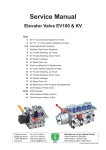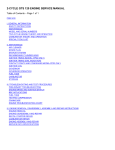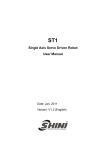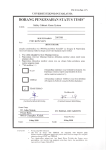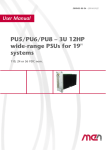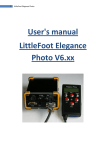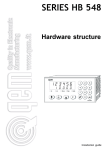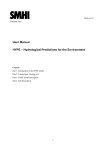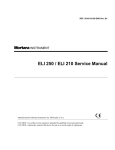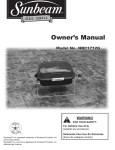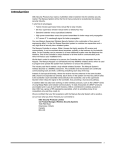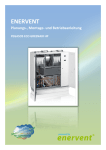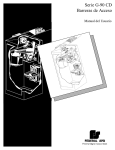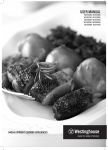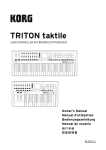Download SS-550/700 User Manual
Transcript
SS-550/700 User Manual Date: 12/2010 Version: V2.0 Shini Plastics Technologies (Dongguan), Inc. TEL:(0769)83313588 Website:www.shini.com Contents 1. Safety ...................................................................................................7 1.1 Safety Regulations.........................................................................7 1.2 Safety Concerns ............................................................................8 1.3 Emergency Stop ..........................................................................11 1.4 Transportation and Storage .........................................................11 1.4.1 Transportation ....................................................................11 1.4.2 Transportation after Unpacking ..........................................12 1.4.3 Storage...............................................................................13 1.4.4 Operation Environment ......................................................13 1.4.5 Retirement..........................................................................14 2. Installation .........................................................................................15 2.1 Instruction ....................................................................................15 2.1.1 Safety Issue........................................................................15 2.1.2 Compressed Air Connection...............................................15 2.1.3 Electric Power Connection .................................................15 2.1.4 Safety Fence ......................................................................16 2.1.5 Mounting Preparation .........................................................16 2.1.6 Mounting Instruction ...........................................................17 2.2 Equipment Specification ..............................................................17 2.2.1 Dimensions (Unit: mm).......................................................17 2.2.2 Model Specification ............................................................18 2.2.3 Pneumatic Source Requirement.........................................19 2.3 Electrical Connection ...................................................................19 2.3.1 Main Power Supply ............................................................19 2.3.2 Interface with the Injection Molding Machine......................19 2.4 Axes Adjustment ..........................................................................20 2.4.1 Adjusting the X-Position .....................................................20 2.4.2 Adjusting the Y-Position .....................................................21 2.4.3 Adjusting the Z-Position .....................................................21 2.5 Gripper and Suction Setting.........................................................22 3(82) 2.5.1 Gripper Setting ...................................................................22 2.5.2 Suction Setting ...................................................................22 2.6 Robot and IMM Interface .............................................................24 2.6.1 Euromap67 Interface..........................................................24 2.6.1.1 The Injection Molding Machine Output Signals........24 2.6.1.2 Robot Output Signals...............................................27 2.6.2 Euromap12 Interface..........................................................28 2.6.2.1 Injection Mounding Machine Output Signals............29 2.6.2.2 Robot Output Signals...............................................31 3. General Description ..........................................................................32 3.1 SS Series Abstract.......................................................................32 3.2 Application ...................................................................................32 3.3 Features.......................................................................................32 3.4 Functions .....................................................................................33 3.4.1 Function Description...........................................................33 3.4.2 Stroke Measuring ...............................................................34 3.4.3 Shock Absorber..................................................................35 3.4.4 Functions Adjustment.........................................................35 3.4.4.1 Forward and Backward Adjustment.........................35 3.4.4.2 Mold Change ...........................................................35 3.4.4.3 Reversing ................................................................36 3.5 Safety Function ............................................................................38 3.5.1 Safety Protection ................................................................38 3.5.2 Emergency Stop.................................................................38 3.6 Adjusting and Setting ...................................................................39 3.6.1 Default Setting....................................................................39 3.6.2 Adjusting the Height of the Gripper ....................................39 3.6.3 Forward and Backward Adjustment....................................40 3.6.4 Change Mold and Maintenance..........................................41 3.6.5 Air Pressure Adjustment.....................................................42 3.6.6 Shock Absorber..................................................................42 3.6.7 The Position of Swinging- in Adjustment ............................43 3.6.8 Adjusting the Swing-out Angle............................................44 4. Operation Instructions......................................................................45 4(82) 4.1 Hand Controller............................................................................45 4.1.1 The Panel of Hand Controller .............................................45 4.1.2 Keys ...................................................................................45 4.2 Manually Operation......................................................................46 4.3 Automatic Operation ....................................................................46 4.4 System Operation ........................................................................47 4.4.1 Stand-by Mode ...................................................................47 4.4.2 Language ...........................................................................47 4.4.3 The Function Setting ..........................................................48 4.4.4 Special Function.................................................................49 4.4.5 Molds Select.......................................................................51 4.4.6 Mold Set .............................................................................51 4.4.7 Teach .................................................................................52 4.4.8 Time Setting .......................................................................53 4.4.9 I/O Monitor..........................................................................54 4.5 Standard Action Program.............................................................54 5. Error Correction ................................................................................57 6. Maintenance.......................................................................................63 6.1 General ........................................................................................63 6.2 Lubrication Requirements ............................................................63 6.2.1 Maintenance.......................................................................64 7. The Assembly Chart..........................................................................65 7.1 Mechanical Assembly ..................................................................65 7.1.1 Base Chart .........................................................................65 7.1.2 Sliding Seat Chart ..............................................................66 7.1.3 Arm Chart ...........................................................................67 7.2 Euromap12 Electric Control Chart ...............................................68 7.2.1 The Main Input Panel Wiring Diagram................................68 7.2.2 The Main Output Panel Wiring Diagram.............................69 7.2.3 Main Control Board Signals Wiring Diagram ......................70 7.2.4 The Main Control Layout Chart ..........................................71 7.2.5 Control Power Diagram ......................................................72 7.3 Euromap67 Electric Control Chart ...............................................73 5(82) 7.3.1 7.3.2 7.3.3 7.3.4 7.3.5 7.3.6 7.3.7 7.3.8 7.3.9 The Main Input Panel Wiring Diagram................................73 The Main Output Panel Wiring Diagram.............................74 Euromap67 Signals Input Panel Wiring Diagram ...............75 Euromap67 Signals Output Panel Wiring Diagram.............76 Main Control Panel and Controller Wiring Diagram............77 Controller Lay-out Drawing.................................................78 The Main Control Layout Chart 1 .......................................79 The Main Control Layout Chart 2 .......................................80 Control Power Diagram ......................................................81 7.4 Pneumatic Circuit Schematic Diagram.........................................82 Table index Chart 2-1: SS Series Robot Specification List ............................................18 Picture index Picture 4-1 ..................................................................................................45 Picture 7-1 ..................................................................................................65 Picture 7-2 ..................................................................................................66 Picture 7-3 ..................................................................................................67 Picture 7-4 ..................................................................................................68 6(82) 1. Safety Before starting up the robot for the first time, please review this manual thoroughly and familiarize yourself with the operation of the robot. Improper use may injure personnel and/or damage the robot, mold or molding machine. 1.1 Safety Regulations ●Please review this manual thoroughly and familiarize yourself with the operation of the robot, before starting up the robot for the first time. Maintenance should be performed by qualified personnel only. ●The SS series robot is designed for injection molding machine (IMM) ONLY. ●Any modification or change to the original design of the robot is forbidden. ●Any improper installation and operation may result in injury to personnel and/or damage to equipments. ●Please contact the manufacturer or local vender immediately if there is any problem with robot when operate it. ●Please note that our robot must be cooperated with other safety device (i.e. safety door) in order to operate in normal condition. ●Ensure all installations are met with safety requirements before operating. ●Without the written consent of the manufacturer, any damage or lost caused by the modification or use beyond the user manual, the manufacturer will not have any responsibility. 7(82) 1.2 Safety Concerns ●The maintenance, repair, etc, must be executed by professionally trained personnel. ●Any unrelated personnel should keep away from robot working area while it is operating. All electrical wiring must be completed by professionals, and in accordance with design of specifications and wiring instructions. ●Use safety fence to indicate working area while installation. ●For the safety operation, the hand controller should be placed outside the robot working area. ●Ensure bolts and nuts are tightened with torque wrench while installation. ● Ensure there is no following matters in the compressive air: phosphate-containing oil, organic solvents, sulfite gas, chlorine, acids and stale compressor oil. ●The air pressure should be kept at 6MPa ±0.1MPa while operation. ●Remove anything from the top of the robot to prevent falling due to vibration. ●Press EMERGENCY STOP button immediately when accident occurs. ● Do not modify the robot body and control box. Please contact manufacturer or vendor if any change is required. ●Turn off power supply and compressed air before maintenance and adjustment. Also set up warming signs and safety fences. ●Please use parts of SHINI if there is any replacement is required. ●Our robots meet all corresponding safety standards. ●Please read the user manual carefully as a safety guideline. ● Unauthorized personnel must inform the relative supervisor and understand all safety rules before entering robot working area. ● Please order a new user manual from the manufacturer or vendor if the user manual is damaged. 8(82) Product owner has the responsibility to ensure the operators, maintenance staffs and relative staffs have read user manual thoroughly. Any modifications or other applications to robot should obtain the written consent from the manufacturer, for safety purpose. The safeguarding required for operation of the robot is not including in our standard scope of supply (except special equipment), since adaptation to specific site conditions is required. If such safeguarding is provided by you, please note that it must be installed prior to startup of the equipment in order to be included in the safety circuit of the system upon startup. The warning marks and its meanings: 9(82) No. Marks Meaning 1 Do not touch. 2 Caution! Danger! 3 Caution! Electric shock. Caution! Mechanical injury. 4 5 Caution! High temperature. 6 No flame. 10(82) 1.3 Emergency Stop The emergency stop button is located on the hand controller. When the emergency stop button is pressed, the power is turned off. The gripper and vacuum valves and the vacuum generator are not disconnected in order to avoid dropping parts from the gripper. In addition, the control system and the hand controller will remain under power to allow indication of error messages. The emergency stop circuits of the robot and of the injection molding machine are connected by the Euromap12 and Euromap67 interface. Therefore when the emergency stop button on the molding machine is pressed the robot will also stop and vice versa. Any problem during using Shini robots, please contact our company or the local vendor. Headquarters & Taipei Factory: China Service Hotline: Dongguan Factory: Ningbo factory: TEL:(02)26809119 TEL:800-999-3222 TEL:(0769)83313588 TEL:(0574)86719088 1.4 Transportation and Storage Prohibit persons underneath the robot during transportation. If there is compelling reason for moving or re-installing the robot, please enquire for assistance from the manufacturer or agents. If you do not comply with this mandatory requirement, result in the injury to any personnel and equipment, the robot manufacturer will not have any responsibility. 1.4.1 Transportation 1. Please use forklift to transport the robot. 2. Before transporting, lock the arm falling-proof bolter to prevent arm out during transportation. 11(82) 3. The arm may rotate, before transporting, turn the shock absorber on rotation cylinder to the limit position, and fix the arm, prevent damage to the arm. 4. During the transporting, please be warned of any collision to damage the robot. 5. In the long-distance transportation, please increase plastic bag, and if necessary vacuum pumping and put desiccant in. 6. The temperature between -25℃ to 55℃ during the transportation, for short transportation (in 24 hours), the temperature can not higher than 70℃. The robot you order before sending out the factory is confirmed in good working condition, please check whether there is any damage during carrying or transporting. Please be carefully, when dismantling of components and packaging, if the robot has found the injury, you can use the package again. Any damage caused by transportation, please: 1) Feedback immediately to the transporting companies and our company. 2) Claim to the shipping company, fill in the file requests for compensation. 3) Retain the damaged items for testing. Do not return the damaged items until the testing is completed. 1.4.2 Transportation after Unpacking When carry the robot please use the special snatch strap (see the picture, the snatch strap belongs to exceptional accessories, you can order it from manufacturer). 12(82) 1.4.3 Storage 1. Switch off the air supply and main power, if the robot is not in use for a long time. 2. Robots should be stored in ventilated, dry room to prevent rust and damping. 3. If not use for a long time, anti-rust of the robot, and if necessary place film to prevent dust and rain water corrosion. 1.4.4 Operation Environment 1. Temperature: Between +5℃ to +40℃ 2. Humidity: Temperature +40℃, relative humidity 50% 3. Elevation: Under 1000 meters above sea level 4. In order to ensure the robot operate normally, please stop using when: 13(82) ① Power wire is broken. ② Air tube is broken. ③ Robot goes wrong or dismantles without professional, before the professional overhauling. ④ Air pressure is not enough or too high. ⑤ There are organic solvent, acidic phospholipids, sulfurous acid, chlorine and flammable and explosive dangerous matter in the compressed air. 1.4.5 Retirement When the robot goes to the end of service life and cannot be maintenance, dismantle it. When dismantle the component parts according to its nature mistrials (metal, oil and lubricants, plastics, rubber, etc.) in different ways. Entrust the authorized commission company and abide the local laws and regulations of solid industrial waste treatment. 14(82) 2. Installation 2.1 Instruction 2.1.1 Safety Issue 1. Before installation, please read this chapter carefully. 2. Follow the installation guide to prevent accidents. 3. Fix the robot base before operating. 4. Indicate the safety fence outside of the robot operation area. 5. Place the hand controller outside of the safety fence. 6. Keep the air tube in good condition when installing robot. 7. The power connection should be performed only by an authorized electrician. 8. Cable connection should obey the local regulations. The grounded wire cannot attach to the water pipe, gas pipe, television cables or telephone lines. 9. Use the independent cable wire and power switch. The diameter of main power’s wire cannot be less than the control box’s wire. 2.1.2 Compressed Air Connection 1. According to the filter specification to choose a suitable hose, then connect it between the gas source and the filter. Note: Before connecting hoses, clean the hose by compressed air. To ensure that there is no cuttings, seal tapes, and so on in the hose. 2. Check the compressed air connection in control box without bending conditions. 3. Turn on the air supply and adjust the air pressure to 5bar at the filter regulator valve. 2.1.3 Electric Power Connection 1. The power connection should be performed only by an authorized electrician. 15(82) 2. Before connecting, cut off the main power supply. 3. Set up safety electrical to protect the control system. Because the power supply informally will destroy the control system. 4. Before installation, wiring, operation, and maintenance please familiar with installation guide as well as machinery, electronics and security attentions. 5. Ground the wire before robot operating. 6. Wire grounding should connect to metal and keep away from inflammable matter. 2.1.4 Safety Fence 1. Indicate the safety fence outside of the robot operation area, after installing robot. 2. Place the hand controller outside of the safety fence. 3. Stick warning logos on the safety fence. 2.1.5 Mounting Preparation 1. Before drilling, switch off the IMM then turn off the power supply in order to prevent any damage to the mold. 2. Put the drilling sticker (as the picture) on the installing surface of IMM. 3. Use the center punch to fix the positions. 16(82) 4. Place electrical drill with magnet base on the fixing plate, use Ф8.5 drill bits to drill 6 holes about 30mm depth. 5. Use M10 tap to produce 6 internal screw threads about 25mm depth. 2.1.6 Mounting Instruction 1. Avoid sharp pounding, collision and falling when transfer the robot to the top of IMM. 2. Adjust the torque spanner to 77Nm after the robot has been fixed on the right position, tighten the M10 × 30 hex socket bolt screws. 2.2 Equipment Specification 2.2.1 Dimensions (Unit: mm) Picture 2-1 17(82) 2.2.2 Model Specification Chart 2-1: SS Series Robot Specification List Model SS-550 SS-700 IMM (ton) 50--150 100--250 Crosswise Stroke (mm) 0--125 0--125 Vertical Stroke (mm) 0--550 0--700 Swing Angle (deg) 50--90 50--90 Wrist Angle (deg) 90 90 Max Load (kg) 0.5 0.5 Min Pick-out Time (sec) 0.8 0.9 Min Cycle Time (sec) 3.0 3.2 Max Air Consumption (Nl/cycle)﹡ 9 10 Power rating (W) 30 30 Rated current (A) 0.5 0.5 Air Pressure (bar) 4--6 4--6 62 64 340×570×1100 340×570×1250 Weight (kg) Dimensions(W×D×H) (mm) Note: 1. “S” stands for suction circuit. “M” stands for middle mold detector. (Suitable for 3-plate mold) “EM12” stands for Euromap12 communication interface. “EM67” stands for Euromap67 communication interface. 2. Power supply requirement: 1Ф, 100~240V, 50/60Hz. 3. “﹡ ” Max air consumption for suction device 30Nl/min. 18(82) 2.2.3 Pneumatic Source Requirement This is connected to the regulator with 1/4-Ф10 tubing. A shut off valve provide off the main compressed air line. Required supply pressure: 5bar When the pressure drop below 4bar, the robot will stop working and alarm. Compressed air consumption depends on the robot accessories. 2.3 Electrical Connection 2.3.1 Main Power Supply The power requirements are given on the serial plate of the robot. The power connection is provided through a normal power cord and a grounded plug. The power connection should be performed only by an authorized electrician according to applicable electric utility regulations. 2.3.2 Interface with the Injection Molding Machine SS series robots are available with 2 different interface versions to communicate with the injection molding machine: ●Euromap12 ●Euromap67 Both versions are described in the following chapters. Connection of the interface plug to the machine and testing of all signals must be done by a specialist in injection molding machines and robots. Preferably, this should be done by one of our service engineers together with a qualified service engineer for the injection molding machine. 19(82) The interface signal functions must be carefully tested, as improper operation may cause malfunction or damage to the robot and molding machine. In particular, the functions of the safety circuits must be thoroughly checked: ● Testing the Emergency Stop signals from and to the IMM. ● When the Emergency Stop switch is activated on the hand controller, the error message emergency stop must also be indicated at the IMM. After acknowledging the error message, the emergency stop must be activated at the IMM. Emergency stop must also occur at the hand controller device and be indicated on the display. 2.4 Axes Adjustment While adjusting, make sure that the robot can not be run and that the compressed air supply is shut off. 2.4.1 Adjusting the X-Position The x-position is determined by tuning the position a and b. Bracket “a” is for adjusting the end-position, and bracket “b” is for adjusting the stroke length and the 0-position. Before running in to the mold range with the Y-axis for the first time, you must check whether the X-positions can be reached without damaging the mode and the Y-axis. First, the end position of the X-axis must be adjusted. Adjusting the end position 20(82) 1) Run the X-axis to its end position 2) Release bracket “a” 3) Push the axis to the desired position manually 4) Fix the stop package Adjusting the 0-position (stroke length) 5) Run the X-axis to 0-position 6) Release stop package “b” 7) Push the axis to the desired 0-position 8) Fix the stop package 2.4.2 Adjusting the Y-Position The upper position is given by the end-position-damper. The withdraw position can be set using the stop block. Adjusting the withdrawal position: 1) Run the Y-axis to its end position 2) Seal off compressed air 3) Loosen Y-axis stop package 4) Push the Y-axis to the desired position manually 5) Push Y-stop to its lowest position 6) Fix the Y-stop-package Stop Block If the Y-axis is shifted, also the withdrawal position changes. 2.4.3 Adjusting the Z-Position The Z-position is determined by adjusting the position of the shock absorber. Before adjusting, release the compressed air. 21(82) 1) Loosen the nuts on the shock absorber 2) Adjust the shock absorber into the desired position 3) Tighten the nuts in place The Z-position must be adjusted so that the Y-axis can be fully run out. In the Z 0-position, the Y-axis must be run out to outside the mode area. 2.5 Gripper and Suction Setting 2.5.1 Gripper Setting When the gripper is opened (did not pick up parts), the light of the magnetic switch should be off. When the gripper picks up parts, the light of the magnetic switch should be on. When the gripper is closed (did not pick up parts), the light of magnetic switch should be off. Adjusting the magnetic switch: 1. Loosen the fixing screw on the magnetic switch 2. When gripper picks parts the light of magnetic switch on, if gripper haven’t picks parts, the light off. 3. Tighten the fixing screw after finishing adjustment. During the robot operation, if the gripper not clamps the parts, the robot will stop operating and alarm. Magnetic Switch 2.5.2 Suction Setting 22(82) 1. Compressed air source setting: The pressure sensor is set at the minimum air pressure when the machine is working, that is, when the input pressure exceeds the value, it will feedback to the system to ensure that the machine work properly. The factory setting of pressure value is 0.4Mpa. As the machine has compressed air loss during working, the value about 0.07Mpa. Therefore, the lowest pressure is 0.4Mpa, the machine can work properly. The atmospheric pressure should be higher than 0.47Mpa. If you need to modify the value, please do it step by step: a. Release the A screw b. Rotating turntable B to “+”, it demands for the higher air pressure to “-”, it demands for the lower air pressure. c. Testing whether the switch output, please check the “pressure limit” of “monitor” page on control panel. Picture 1-8 2. Suction pressure setting: The suction with negative-pressure measuring function, when negative pressure is set to the preinstalled value, it will feedback and output to the system. The negative pressure value set -60% as factory setting. So, when negative pressure up to -60%, signal output. If need to modify the value: 1. Loosing screw C. (see as the picture 1-8) 2. Rotate screw D, Counterclockwise rotation in order to reduce negative pressure value; Clockwise to increase the negative pressure value. 3. After setting, lock screw D. Adjusting the negative pressure values as well as adjusting the delay time of adsorption action. If the vacuum generator in a certain situation, the lower the negative pressure values, longer time need. 23(82) 2.6 Robot and IMM Interface SS series robots are available with 2 different interface versions to communicate with the injection molding machine: ●Euromap67 ●Euromap12 Both versions are described in the following chapters. 2.6.1 Euromap67 Interface Euromap67 interface defines the connection plug between the injection molding machine and the robot: The robot-injection molding machine interface is designed according to the directives of Euromap67, which states: Unless otherwise noted, the signals, which are maintained during the described function. 2.6.1.1 The Injection Molding Machine Output Signals Pin Contact NO. ZA1 Function Emergency stop channel 1 The emergency stop switch of the injection molding machine is used 24(82) ZC1 ZA2 ZC2 to interrupt the emergency stop circuit of the robot. Emergency stop channel 2 The emergency stop switch of the injection molding machine is used to interrupt the emergency stop circuit of the robot. Safety system active channel 1 ZA3 ZC3 For protecting against hazardous motions of the robot. The switch is closed when the safety system of the injection molding machine is active. Safety system active channel 2 ZA4 ZC4 For protecting against hazardous motions of the robot. The switch is closed when the safety system of the injection molding machine is active. Reject ZA5 optional The signal is HIGH when the molded piece is a reject. The switch is closed when the tool is open and must remain HIGH at least until “close tool enabled”(see pin contact No.A6). Mold closed ZA6 HIGH signal when tool closing has been completed, the signal “close tool enabled” is no longer necessary (see pin contact No.A6). Mold open ZA7 HIGH signal if the mold opening position is equal or more than the required position. Inadvertent alteration to mold opening stroke smaller than that required for the robot to approach must be impossible. Mold at intermediate position HIGH signal when the mold opening has reached the specified intermediate position and remains HIGH until the mold is completely open. The signal may be used in two ways: ZA8 optional 1)The mold stops in the intermediate position, whereupon a signal is sent to the robot. Completely opening of the IMM takes place through the signal “complete mold opening enabled”(see pin A7). 2 ) The IMM transmits the signal, but does not remain in the intermediate position. Signal is LOW when the intermediate. ZA9 Signal voltage robot 24V DC ZB2 Fully automatic mode injection molding machine 25(82) HIGH signal, when operating the injection molding machine tighter with the robot is possible. Ejector back position ZB3 HIGH signal when the ejector is back, regardless of the position of the movable tool plate. The signal acknowledges “ejector back enabled” (see pin contact No.B3). Ejector forward position ZB4 HIGH signal when the ejector is forward. The signal acknowledges “ejector forward enabled” (see pin contact No.B4). Core pullers 1 free for robot to approach ZB5 HIGH signal when the core pullers are in position for removal of the injection molding(see pin contact No.B5). Core pullers 1 in position to remove molding ZB6 HIGH signal when the core pullers are in position for removal of the injection molding (see pin contact No.B6). Core pullers 2 free for robot to approach ZB7 optional ZB8 optional ZC5/ZC6/ZC7 HIGH signal when the ejector is back, regardless of the position of the movable tool plate are in position for the robot to approach(see pin contact No.B7). Core pullers 2 in position to remove molding HIGH signal when the core pullers are in position for removal of the injection molding (see pin contact No.B8). Reserved for future Euromap signal ZC8 free ZC9 Signal Ground Robot 0V 26(82) 2.6.1.2 Robot Output Signals Pin contact No. A1 C1 A2 C2 Function Emergency stop of robot channel 1 The emergency stop switch of the robot aborts the control system of the molding machine. Emergency stop of robot channel 2 The emergency stop switch of the robot aborts the control system of the molding machine. Mold area free A3 C3 Signaling is effected by the limit switch at the travel in rail. The switch is opened. When the travel in rail, in the region of the injection molding machine, leaves its starting position before it is moved into the tool area. If the switch is open, neither a closing nor opening motion of the tool may take place. Even when the control system of the robot is shut off, the switch must work as described. A4 Reserved for future Euromap signal. C4 A5 free Complete mold opening enabled A6 HIGH signal when the robot is far enough out of the tool that it can be closed and when other robot control systems enable closing of the tool. The signal remains HIGH signal for the duration of the tool closing operation, the event of a LOW signal due to a disturbance, the tool-closing motion must be aborted. Note: the signal “close tool enabled” may not be linked with other or signals in any operating mode (see pin contact No.ZA47). Complete mold opening enabled A7 optional HIGH signal when the robot is far enough out of the tool that it can be closed and when other robot control systems enable closing of the tool. The signal remains HIGH signal for the duration of the tool closing operation. In the event of a LOW signal due to a disturbance, the tool-closing motion must be aborted. Note: the signal “close tool enabled” may not be linked with other or signals in any operating mode (see pin contact No.ZA47). A8 Reserved for future Euromap signal A9 Signal Ground IMM 24V DC Operation with robot B2 LOW signal when the robot mode switch is “operation with injection molding machine”. HIGH signal when the robot mode switch is “no operation with 27(82) injection molding machine” HIGH signal when the robot is switched off. Ejector back enabled B3 HIGH signal when the removal operation has been performed far enough for the motion “ejector back” to be carried out. The signal is HIGH for the duration of the motion “ejector back”.The signal must be maintained at least until the signal “ejector back” from the molding machine.(see pin contact No.ZB3) Ejector forward enabled B4 B5 optional B6 optional B7 optional B8 optional HIGH signal when the removal operation has been performed far enough for the motion “ejector back” to be carried out. The signal is HIGH for the duration of the motion “ejector back”. The signal must be maintained at least until the signal “ejector back” from the molding machine.(see pin contact No.ZB4) Enable movement of core pullers 1 to position for the robot to approach freely. HIGH signal when the motion of the core pullers is to the position for the robot to approach freely is enabled. (see pin contact No.ZB5) Enable movement of core pullers 1 to position for removal of the molding When the motion of the core pullers is to the position for removal of the molding is enabled. Enable movement of core pullers 2 to position for the robot to approach freely. HIGH signal when the motion of the core pullers is to the position for the robot to approach freely is enabled. (see pin contact No.ZB7) Enable movement of core pullers 2 to position for removal of the molding. When the motion of the core pullers is to the position for removal of the molding is enabled. (see pin contact No.ZB8) C5 free C8 C6 Reserved for future Euromap signal C7 C9 Reserved for future Euromap signal 2.6.2 Euromap12 Interface The interface consists of the plug connection between the injection molding machine and the robot: 28(82) The robot-injection molding machine interface is designed according to Euromap12, which state: Unless otherwise noted, the signals are maintained during the described function. 2.6.2.1 Injection Mounding Machine Output Signals Plug Contact NO 1,9 2 3,11 4 5 6 optional Function Emergency stop of machine The emergency stop switch of the injection molding machine is used to interrupt the emergence stop circuit of the robot. Mold open The switch contact (pin contact 16) is closed when mold opening position is equal or more than required position. Inadvertent alteration to mold opening stroke smaller than that required for the handing device to approach must be impossible. Safety system active The switch contact is closed when safety devices (e.g. safety guard, footboard safety, etc.) on the injection molding machine are operative so that dangerous movements of the handing device/robot are possible. The signal is active in any operation mode. Ejector back The switch contact is closed when the ejector has been retracted regardless of the moving platen position. (See pin contact No.16) acknowledgement for the “Enable ejector back” signal (see pin contact No 21), when the ejector sequence is selected. (see pin contact No.16) Ejector forward The switch contact (see pin contact No.16) is closed when the ejector has been advanced. The signal is the acknowledgement signal for the “enable ejector forward” (see pin contact No 22). It is recommended to close the switch contact when the ejector sequence not in use. (see pin contact No.16) core pullers free for robot to travel in Switch (see pin contact No.16) is closed when the core pullers, regardless of the position of the movable tool plate, are in position for free travel–in of the robot. 29(82) 7 optional 8 optional 10 12 core pullers in position for removal of injection moldings Switch (pin contact No.16) is closed when the core pullers are in position for removal of the injection molding. Reject Switch (see pin contact No.16) is closed when the molded piece is a reject. The switch must be closed when the tool is open and must remain closed at least until “enable mold close”. (see pin contact No.17) Fully automatic mode injection molding machine Switch (see pin contact No.16) is closed when the operating mode selector switch is on “semi-automatic” or “fully automatic mode”. Mold closed Switch (see pin contact No.16) is closed when the mold closing has been completed, the signal “enable close” is no longer necessary. (see pin contact No.17) 13 optional Free 14 optional Mold at intermediate position Switch (see pin contact No.16) is closed when the IMM has reached the specified intermediate position and remains closed until the IMM is completely open. The signal may be used in two ways: 1) Mold opening stops on intermediate position and gives start signal to handling device/robot. mold opening restarts with the signal “Enable full mold opening”(see contact No.28) 2) Mold opening doesn’t stop on intermediate position, however gives the signal to handling device/robot. (see pin contact No.16) The switch contact is open when intermediate mold opening position is not in use. 15 optional 16 Free Signal voltage of robot 30(82) 2.6.2.2 Robot Output Signals Plug Contact NO 17 18,26 19,27 20 21 22 23 optional 24 optional 25 28 optional 29 30 31 Function Enable mold close The switch contact (see pin contact No.32) is closed when the robot is retracted enough for start of mold closure. the switch contact must remain closed at least until “mold closed” (see pin contact No.12) Mold area free The switch contact is closed when the robot is retracted enough for start of mold closure. If the switch contact opens as a result of a fault, mold closing must be interrupted. The switch contact must be closed if the robot is switch off. It is recommended to close the switch contact when the robot is unselected. Emergency stop of robot Opening of the switch contacts of the robot must shut off the control system of the molding machine. Operation with robot The switch contact (see pin contact No.32) is open when the robot mode switch is “Operation with injection molding machine”. The switch contact is closed when the handling device mode switch is: “No operation with injection molding machine” the switch contact (see pin contact No.32) is closed when the robot is switched off. Enable ejector back The switch contact (see pin contact No.32) is closed when the handling device enables the movement for ejector back, the switch contact must remain closed at least until “Ejector back” signal is given by injection molding machine (see contact No 4). Enable ejector forward The switch contact (see pin contact No.32) is closed when the handing device enable the movement for ejector forward. The switch contact must remain closed at least until “ejector forward” signal is given by the injection molding machine (see contact No 5). Enable motion of core pullers for removal of injection moldings The switch contact (contact no. 32) is closed when the enable motion of core pullers for removal of injection moldings. It is recommended that the switch contact remains closed at least until “the core back to end” signal is given by injection molding machine (see contact No 7). Enable motion of core pullers for removal of injection moldings The switch contact (contact no. 32) is closed when the enable motion of core pullers for removal of injection moldings. It is recommended that the switch contact remains closed at least until “the core back to end” signal is given by injection molding machine (see contact No 7). Reserved for future use by EUROMAP Enable full mold opening The switch contact (see pin contact No.32) is closed when the handling device has taken the part and allows to continua mold opening. The switch contact must remain closed until “mold open” signal is given by the injection molding machine (see contact No.2). If the switch contact is not used it must be open. Reserved for future Euromap signal Free Free 31(82) 3. General Description 3.1 SS Series Abstract The SS series robot is designed for rapid and precise removal of spure and runner from injection molding machine, and place them into granulator for recycling. Simple product removal is applicable with optional vacuum generator and EOAT. SS-550 and SS-700 offer vertical arm displacements of 550mm and 700mm that are suitable for injection molding machines with clamp forces of 150t and 250t respectively. SS series is designed with compact structure, elegant appearance, smooth motion, user friendly interface, and imported pneumatic accessories. Model: SS Series Robot 3.2 Application 1) SS-550 is suitable for the use with plastics injection molding machine under 150t. 2) SS-700 is suitable for the use with plastics injection molding machine under 250t. 3.3 Features 1) Arm Mechanism 32(82) The arm mechanism is integrated with branded pneumatic cylinder, efficient shock absorber, drop proof locking mechanism, compact and adjustable gripper, self clean plastic bearing, 90°wrist rotation mechanism and gripper sensor. 2) Swing Mechanism Employs rack and pinion system which converts linear motion to rotation with least damage to the cylinders. The shock absorber and angle tuning system provides a smooth and precise swing motion. 3) Kick Stroke Mechanism Employs heave duty linear rail and ball bearing, pneumatic cylinder with adjustable speed and displacement and shock absorber. 4) Base Mechanism Fast mold changing design provides simple method for changing molds. The base is rotating for 90°by releasing the handle. 5) Pneumatic Circuit Branded pneumatic accessories provide extensive use life. Removable electric circuit stands allows easy maintenance. 6) Control System Dialogic hand controller provides English, Japanese, Traditional Chinese and Simplified Chinese. Other languages are applicable; up to 8 different languages can be stored. There are 8 standard programs and memory for up to 80 customized programs with self fault detection. Swing directions are adjustable simply by flipping the switch on the control board. Position limit sensors are applied to all moving directions in order to provide safety mechanically and electrically. Extra 4 sets of I/O pins are available for other applications. Designed to EUROMAP12, EUROMAP67 and SPI to provide plug and use. 3.4 Functions 3.4.1 Function Description Designed for rapid and precise removal of sprue and runner from injection molding, and place them into granulator for recycling. Simple product removal is applicable with optional vacuum generator and 33(82) EOAT. Suitable for injection molding machine under 250T clamp force. In order to ensure the robot works smoothly, there are shock absorbers and magnetic sensor switches on the main parts of the robot, and having pneumatic cut off protection device on arms. 3.4.2 Stroke Measuring There are magnetic switches on the front and back of the kick stroke cylinder and having the proximity switches on the left and right sides of the rotation cylinder and arms, use to measure whether the cylinder stroke is normal. There is a magnetic switch on the gripper, use to measure whether gripper picks up parts. If any parts of robot goes wrong, it will stop working and alarm till eliminate troubles. Picture 3-2 34(82) 3.4.3 Shock Absorber Shock Absorber on Kick Stroke Picture 3-3 3.4.4 Functions Adjustment 3.4.4.1 Forward and Backward Adjustment The robot base joined with the stand parts by thread. When need adjust the robot position, use spanner loosen the fixed screw, rotate the hand wheel, the base can move forward or backward. After adjusting, tighten the screw. Picture 3-3 3.4.4.2 Mold Change The robot has rotating function. 35(82) Loosen the fixed screw and rotate the robot for 90 degrees in the case if changing mold, as show in picture 3-4. Picture 3-4 3.4.4.3 Reversing The robot designed with crossed T-groove. Loosen the screws which on the arm to change the robot’s arm swing out direction. Turn the trapezoidal convex to the other T-groove, then tighten the screw, and turn the reversing switch to the other side, the arm will change the swing direction. The robot places goods in non-operation position as the factory setting. The flowing steps are the robot places goods in non-operation position change to the operation position. 1. Loosen the arm connecting screw, counterclockwise arm 90° to make the arm in horizontal, then tighten the screw. Arm Connecting Screw 36(82) 2. After adjusting arm, move the switch (in non-power and non-pneumatic state) on circuit board from “L” to “R” position. After power on and pneumatic on, the arm almost in vertical state. Reversing Switch 3. Adjusting the shock absorber on the right of sliding seat, made the arm in the completely vertical state and the gripper opened direction vertical with the sliding seat slipping direction. Shock Absorber 4. Loosen the fixing gripper screw, clockwise 90° gripper made gripper opened direction vertical with the sliding seat slipping direction. 37(82) Fixing Gripper Screw 3.5 Safety Function 3.5.1 Safety Protection The robot with cut off pneumatic protection device, can prevent the damages cause by arm falling when air pressure is not enough. If the air pressure is not enough, the sensor will output the signal. The robot’s arm keeps in current position or returns to the up limitation position, then the pneumatic cut off protection device locks the piston rod (if the arm out from inner mold, it will keep at current position, if out from the outside of mold, the arm will back to the up limitation position). When the air pressure is sufficient, the pneumatic cut off protection device will set free and the robot will work again. In addition, there is a manual ring on the device. When the air pressure is insufficient and the arm is in locked state, the customer can manually pull the ring and pull out the piston rod to move it. 3.5.2 Emergency Stop There is the emergency stop button on the hand controller. When the emergency stop button is pressed, the robot will stop working. The gripper and vacuum valve and the vacuum generator are not disconnected in 38(82) order to avoid dropping parts from the gripper. In addition, the hand controller will remain under power to allow indication of error messages. If robot goes wrong or need to maintenance, please press the emergency stop button to ensure operation safety. Emergency Stop Switch Picture 3-6 3.6 Adjusting and Setting 3.6.1 Default Setting When the robot sends out of the factory: 1. The direction of the arm rotation is left. 2. The pressure sensor is 4bar. If the air pressure is less than 4bar, the robot will stop working and alarm. 3. The filter-regulator setting in 5bar. 3.6.2 Adjusting the Height of the Gripper 1. If the vertical stroke is not enough to pick out the parts in mold, adjust the height of baffle plate as well as adjust the height between gripper and base. 2. If the baffle plate is at the up limit, the arm was still unable to get down to pick out the parts in mold, loosen fixed screw on arm, move arm to the lower position. 39(82) Baffle Plate Loosen Fixed Screw 3.6.3 Forward and Backward Adjustment 1. If the kick stroke is short that can not let the arm pick out the parts from inner mold, adjust the slide base position (backward or forward). 40(82) 2. When adjust the position of the sliding base, loosen the fixed spanner, then rotate the hand wheel on the base. After move base to proper position, fix it use fixing spanner. Note: After adjusting the base, must tighten it use spanner, prevent the accidents when robot operating. Picture 3-5 3.6.4 Change Mold and Maintenance The robot with the change mold function convenience to change mold or maintenance. Loose the fixed screw below the base, rotate the base 90°. After adjustment, rotate base back and lock the fixing screw. Picture 3-6 41(82) 3.6.5 Air Pressure Adjustment 1. After installing the robot, rotate the air pressure adjustment button which on the filter regulator, adjust the pressure to the 5bar (default setting). 2. All the drive-cylinder fittings are used speed control fitting. Adjust the air flow to change the speed of the drive-cylinder. Picture 3-7 3.6.6 Shock Absorber Before the robot send out of our factory, it has been tested strictly. But, because of the different working surroundings, the robot may be not operating smoothly as expected. Adjust the shock absorber, the steps as flowing: 1. There is an adjustment shock absorber on rotation cylinder. Loosen the adjustment knob by inner hexagon spanner in counterclockwise direction, adjust the knob lightly to desired point. Picture 3-8 42(82) Note: There is scale numbers (1 to 9) on shock absorber, 1 means the minimum buffer, 9 is the maximum. While adjusting, let the yellow point aims at the desired scale. After adjusting, tighten the fixing screw in clockwise direction. 2. Both the cylinders on the arm and kick stroke are with built-in buffer device. Adjust the buffering as your demands. Note: According the cylinder’s model to choose the size of the adjustment tool. Adjust in clockwise direction, the buffering power become large, counterclockwise direction is reverse. Buffer Adjustment Hole Picture 3-8 3.6.7 The Position of Swinging- in Adjustment 1. In general, the position of the arm swinging-in is in vertical statement. If the mold is special designed, and the injection door is not in the center of the mold, you can loosen the fixed nut on shock absorber of rotation cylinder to adjust the limited height and the position of the arm swing-in. a. When arm swing left, if the swing-in position turn left, should rotate the left shock absorber in counterclockwise. b. When arm swing left, if the swing-in position turn right, should rotate the 43(82) left shock absorber in clockwise. c. When arm swing right, if the swing-in position turn left, should rotate the right shock absorber in clockwise. d. When arm swing right, if the swing-in position turn right, should rotate the left shock absorber in counterclockwise. Note: After change the arm reversing, also need adjust the arm swing-in position as the above methods. Fixed Nut of Shock Absorber Picture 3-10 3.6.8 Adjusting the Swing-out Angle The range of swing-out angle is 50 to 90 degree. You can adjust the position of the shock absorber on the rotation cylinder to adjust the swing-out angle. a. When arm swing left; rotate the right buffer in counterclockwise to increase the swing-out angle, in clockwise direction is reversing. b. When arm swing right, rotate left buffer in counterclockwise to increase the swing-out angle, in clockwise direction is reversing. 44(82) 4. Operation Instructions 4.1 Hand Controller 4.1.1 The Panel of Hand Controller Picture 4-1 4.1.2 Keys Main arm up/down Main arm forward/backward Main arm clip on /off Arms swing in /out 45(82) Vacuum sucker on /off Spare valve on/off (use to control the conveyor and transporter.) Sub-arm up/down Sub-arm forward/backward Sub-gripper clip on /off Mold close 4.2 Manually Operation Press MANUAL key, toggle the display to the manual operation. Press the keys on the hand controller to set desired robot action. Before manually setting, please confirm: 1. The “mold opened” signal. 2. Insure arms will not knock against surrounding subjects. Manual Input NoAct Picture 4-2 4.3 Automatic Operation Press AUTO key, show the display (see picture 4-3), and enter into auto operating model. Auto time (AutoTime): Record current automatic cycle time. 46(82) Set yield (SetYield): Anticipate the production quantity of the enactment. When the current yield arrives to the set yield quantity, the robot will alarm. Current yield (CurYield): the quantities robot picks. Current action (CurrAct): current action of robot. Set time (Settime): The current time of the whole usage. Operate time (Operatetime): The current action is physically time use. Picture 4-3 4.4 System Operation 4.4.1 Stand-by Mode After power on, the control system enter into the self-examination page, and then enter to the STAND-BY page. Also can press STOP key into STAND-BY page when robot operating normally. Press the FUNC keys to set the desired function, after setting, press the STOP key to save the setting and back to stand-by page. 4.4.2 Language After entering into stand-by page, press LANG key to set language. Press ENTER key to change between simplified Chinese, traditional Chinese, English and Japanese. Picture 4-4 47(82) 4.4.3 The Function Setting In stand-by page, press FUNC key to enter the function choice page. Press or key on the hand controller, use cursor to choice the desired function, press ENTER key to change and save the setting. Eje.Use:Use MainChck:Positv SubCkeck:Positv VacmChck:Use Picture 4-5 1. Ejection relation (Eje.Use): NoUse: “Enable ejector forward” and “Enable ejector back”, the signals output all time. Use: After opening mold, output “enable ejector forward” signal. 2. Main gripper examination (MainChck): Positive: examine gripper in positive. If the gripper picks up parts successfully, the gripper outputs signal ON. Negative: examine gripper in negative. If the gripper picks up parts successfully, the gripper outputs signal OFF. NoUse: not examine gripper. Whether gripper picks up parts successfully or not, it is not test the signals. 3. Sub-gripper examination (SubCkeck): the same as the main gripper. 4. Vacuum examination (VacmCkck): NoUse: in auto operation, it is not test the vacuum signals. Use: in auto operation, if the vacuum sucker sucking parts successfully, it is output signal ON. 48(82) 4.4.4 Special Function In stand-by page, press FUNC key twice, enter into the password setting page, input “5488”, then press ENTER key to enter the special function page. Press UP/DOWN key, use the cursor to move to desired function key, press ENTER key to save and acknowledge the setting. PrerCnt:0 Stay:NoUse DoorOpen:Orig CycTime:60.0 Sound:ON PressChk:Use AlarmTime:12.0 ProdClr:OFF AutoSignalNoUse SafeDoor:Use StopSafe:Use Picture 4-6 1. Spare counter (PrerCnt): If the value is 00 for not using spare counter. If setting the value, the spare valve output counters according to movement of sub-interval mold. If value is 1 stands for each mold output the spare valve, 2 stands for two molds output spare valve once only. 2. Cycle time (CycTime): The cycle time is for robot monitors pick-out action. Means the maximum time from current cycle complete to the next Injection Machine mold opened limit. If waiting time exceed the set value, alarm raise. 3. Alarm time (AlarmTime) Setting the alarming period time, exceed the time, the robot will stop alarm but the alarming page will still indicate on the screen. 4. Safety door (SafeDoor): NoUse: not testing the signals of safety door. 49(82) Note: This state only refers authorized people to use this setting, when installing and testing robot. After finishing, it must be set at “use" of state. Use: When arm down to pick up the parts, the safety door can test the signals. 5. Waiting outside of mold (Stay): NoUse: robot operates in auto mode, the arms wait inside for next cycle, as the module program action. Use: robot operates in auto mode, the arms wait outside for next cycle, and then rotate inside before the module program action. 6. Key sound (Sound): Off: No sound while pressing. On: Sound while pressing. 7. Products’ number cleared (ProdClr): Off: robot operates in auto mode, set the products’ number, when reaching the setting number, the robot will stop and alarm. On: In auto mode, not counter the products’ number, the number always shows "0”. 8. Stop uses the safety door (StopSafe): NoUse: The injection molding machine locks mold not controlled by the robot. The robot stop working and “open mold finished”, allow injection molding machine close mold for a long-term. Note: This state only refers authorized people to use this setting, when install and testing robot. After finishing, it must be set at “use" of state. Use: When robot stops working and “open mold finished”, the door must open and close one time, then enable the IMM closed mold. 50(82) 9. Door open (DoorOpen): Reset: In robot auto operating mode, open the safety door and the arm will return to origin point. Stop: In robot auto operating mode, open the safety door and arm stops working at once. 10. Air pressure checks (PressChk): NoUse: not test air pressure signal. Use: when the air pressure is not reach the setting, arm stop working. The hand controller will show air pressure is not enough. 11. Fully auto (AutoSignal): NoUse: not test the fully auto operating signals. Use: When having the fully auto operating signals, the robot can work in auto mode. When the signal cut off, the robot will stop when the action cycle finished. 4.4.5 Molds Select In stand-by page, press SAVE key to enter into molds choice page (refer to the molds action pictures). Choice the desired molds and press ENTER key to save the setting. **MoldSele** Select:(0-99)?00 Picture 4-7 4.4.6 Mold Set To copy the mold recipe, press SAVE key twice to enter into copy molds page. The user can choose one program from 0-99 to read it and then put it into 20-99 to memory as the code of the mold. 51(82) **CopyMold** Read:(0-99)?00 Writ:(20-99)?20 Picture 4-8 4.4.7 Teach In stand-by page, press TEACH Key to enter the TEACH page. **Prog** **Prog** Read:(0-99)?00 2002Thim.Dly01 Writ:(20-99)?20 2003MainDown01 2004MoldEnd Picture 4-9 Read the standard action program (0-19 set) or user defined program (20-99 set), save to the program contents change behind again 20-99 set. After set "read" press ENTER key, the curser move to "write", then set the "write" program, press ENTER key to enter the teach program. In action area, press up/down key to correct step by step, after doing it, modification complete after press ENTER key and current recipe is saved. The robot will work and turn to next program. 20 modes number 03 steps number main arm down action 52(82) 01 action time INSERT: input one order without actions in the teach program. DELETE: delete one order from teach program. Note: a. Must have “mode opened” signal from injection molding machine, then can enter into the TEACH page. b. In teach mode, the robot will work according to the steps. Please pay special attention to the arm’s displacement to prevent collision. c. All molds action begins from original point and at the end of the cycle back to it, otherwise the action program is incomplete and robot cannot operate in auto mode. Original point actions 1. Arm upgoing 5. Gripper open 2. Crosswise back 6. Suction off 3. Rotation in 4. Chamfer wrist 7. Spare output/input off 4.4.8 Time Setting In stand-by page or auto page, press TIME key to enter into the time modification page. Press up/down key to move the cursor to proper step. Press ENTER key after modify. NOTE: 1: The time of after the step-by-step action sequence is the working delay time, the delay time end, executing the current action. 2: If an action needs limit ON/OFF check, after time delay, the act starts and the next step action will wait until the limit signal arrived. Picture 4-10 53(82) 4.4.9 I/O Monitor In stand-by or auto page, press WATCH key to enter into the I/O monitor page. Use the up/down key to move the curser and monitor the input and output signals. INPUT LS 1. UpLmt 2. DownLmt 3. MainGripsLmt 4. SuckLmt 5. MiddLmt 6. PressLmt 7. RotateInLmt 8. RotateOutLmt 9. ForwLmt 10. BackLmt 11. UrgentStopIn 12. OpenCmpl 13. SafeDoor 14. Eje.BackLmt 15. Eje.ForwLmt 16. AutoSignal 17. CloseFinsh OUTPUT SQL 1. DownValve 2. ForwValve 3. MainGripsValve 4. SuckValve 5. RotateInValve 6. RotateOutValve 7. SpareValve 8. AlarmValve 9. ClosePermit 10. UrgentStopOut 11. Eje.BackPermit 12. Eje.ForwPermit 4.5 Standard Action Program Program 0: Clip the moving side 0000 produce quantity 0001 open mold delay 0002 ejection delay 0003 the main arm down 0004 the main arm forward 0005 the main arm clip 0006 main arm backward 0007 main arm up 0008 rotate outside 54(82) 0009 the main arm down 0012 rotate inside 0010 main arm put down 0011 main arm up Program 1: Clip the fix side 0100 produce quantity 0101 open mold delay 0102 ejection delay 0103 main arm forward 0104 main arm down 0105 main arm backward 0106 the main arm clip 0107main arm forward 0108 main arm up 0109 rotate outside 0110 main arm down 0111 main arm put down 0112 main arm up 0113 rotate inside Program 2: Clip the fix side 0200 produce quantity 0201 open mold delay 0202 ejection delay 0203 main arm down 0204 The main arm clip 0205 main arm forward 0206 main arm up 0207 main arm backward 0208 rotate outside 0209 main arm down 0210 main arm put down 0211 main arm up 0212 rotate inside Program 3: Clip the moving side 0300 produce quantity 0301 open mold delay 0302 ejection delay 0303 main arm forward 0304 main arm down 0305 the main arm clip 0306 main arm backward 0307 main arm up 0308 main arm forward 0309 rotate outside 0310 main arm down 0311 main arm put down 0312 main arm up 0313 rotate inside Program 4: Suck the moving side 0400 produce quantity 0401 open mold delay 0402 ejection delay 0403 main arm down 0405 vacuum absorb 0406 main arm backward 0407 main arm up 0408 rotate outside 0409 main arm down 0410 the vacuum put 0411 main arm up 0412 rotate inside Program 5: Clip and Suck the moving side 55(82) 0500 produce quantity 0501 open mold delay 0502 ejection delay 0503 main arm down 0504 main arm forward 0505 vacuum absorb 0506 the main arm clip 0507 main arm backward 0508 main arm up 0509 rotate outside 0510 main arm down 0511 the vacuum put 0512 main arm up 0513 main arm down 0514 main arm put down 0515 main arm up 0516 rotate inside Program 6: Mold inside put down to the moving side 0600 produce quantity 0601 open mold delay 0602 ejection delay 0603 main arm down 0604 main arm forward 0605 the main arm clip 0606 main arm backward 0607 main arm put down 0608 main arm up Program 7: Mold inside put down to the fix side 0700 produce quantity 0701 open mould delay 0702 ejection delay 0703 main arm forward 0704 main arm down 0705 main arm backward 0706 the main arm clip 0707 main arm forward 0708 main arm put down 0709 main arm up 56(82) 5. Error Correction Error Error Caused Error Correction After power on, the light on the hand controller is not light. 1. Emergency Stop key on the hand controller was pressed. 2. 37P plugs loosed or not connected. 3. Power wire errors. 4. Fuse burning-off. The screen of hand controller is gray, when power ON. Under voltage. Error Number 01 05 R.In Lmt ON 06 R.Out Lmt ON Both the rotation in and out limit having signal Error Number02 01 rise lmt ON Error Number 03 01 rise lmt OFF Down valve worked already, having the signal of down valve .the motion of arm downing doesn’t finish in set time. Down valve no motion, and the up limit no signal, the motion of the arm upping don't finish in set time. 57(82) 1. Loosing the Emergency Stop key on the hand controller. 2. Check the 37P plugs. 3. Check the power wire. 4. Check and change the fuse. Adjusting the screw in lateral face of the controller until the display of hand controller clearly. 1. When the arm is swing in, check the light of rotation out limit is lighting all the time. 2. When the arm is swing out, check the light of rotation in limit is lighting all the time. 3. Check I/O’s connecting wire. 4. Whether having troubles on power board. 11. Whether the air pressure is too low. 2. Whether the arm go down. 3. Whether having the signal of up limit. 4. Check I/O’s connecting wire. 5. Whether having trouble on power board. 1. Whether the air pressure is too low. 2. Whether the arm go up. 3. Whether having the signal of up limit. 4. Check I/O’s connecting wire. 5. Whether having trouble on power board. Error number 04 07 Vacuum ON The sucker working and the vacuum suck no signal input. 04 Suck lmt OFF Error Number 05 04 Main Clip ON Main clip valve working, main clip limit no input. 02 Main Clip lmt OFF Error Number 07 07 Vacuum OFF Suck valve no action, vacuum suck having signal 04 Suck lmt ON Error Number 08 04 Main Clip OFF 02 M.Clip lmt ON Main clip valve no working .main clip signal on. Error Number 10 06 R.out ON 06 R.Out Lmt OFF Rotation out valve working, rotation out limit off, the action didn’t finish in the schedule time. Error Number 11 06 R.out OFF 05 R.Out Lmt OFF Rotate out valve no action; rotate in limit doesn’t input, the rotate in doesn’t finish in the schedule time. Error Number 12 04 Main Clip ON 02 M.Clip lmt ON Main clip on, main clip limit no input. Error Number 14 03 main forward valve On 09 main backward lmt On Main forward valve working, main backward valve having signal. 58(82) 1. Whether the air pressure is too low. 2. Check if sucker suck the products and liquid the air. 3. Check I/O’s connecting wire. 4. Whether having trouble on power board. 1. Whether the air pressure is too low. 2. Whether the main clip testing function is right. 3. Check if the main clip can clip the products. 4. Check I/O’s connecting wire. 5. Whether having trouble on power board. 1. Check if the suck limits having signals. 2. If the suck magnetic valve having trouble. 3. Check I/O’s connecting wire. 4. If having trouble on power board. 1. Whether the main clip having signaled. 2. Whether the main sack magnetic valve having trouble. 3. Check I/O’s connecting wire. 4. Whether having trouble on power board. 1. Whether the air pressure is too low. 2. Whether the robot rotating out. 3. Check Whether the rotation limit having signals. 4. Check I/O’s connecting wire. 5. Whether having trouble on power board. 1. Whether the air pressure is too low. 2. Whether the robots rotating in. 3. Whether the rotating having signal. 4. Check I/O’s connecting wire. 5. Whether having trouble on power board. 1. Whether main clip valve testing function is reverse. 2. Whether the air pressure is too low. 3. Check Whether the main clip can clip the products. 4. Check I/O’s connecting wire. 5. Whether having trouble on power board. 1. Whether the air pressure is too low. 2. Whether the robot go forward. 3. Whether having the backward limit signal. 4. Check I/O’s connecting wire. Error Number 15 03 main forward valve Off 09 main backward lmt Off Main forward valve no action, backward limit no input, the backward action didn't finished in the schedule time. Error Number31 01 rise lmt OFF Not Origin Up limit no signal, Robot not return in the waiting point. Error Number32 05 R.In Lmt OFF Not Origin Rotation in limit no signal input, Robot doesn’t return the waiting point. Error Number33 06 R.Out Lmt ON Not Origin Rotation out limit no signal input, Robot not returns in the waiting point. Error Number34 07 Mid.Mold lmt OFF Not Origin When manual or teach, middle mold limit no signal input. Error Number35 09 Mold Opened Lmt OFF Not Origin When manual or teach, the opened mold limit no signal input. Error Number45 Before Rotate 02 MainDownON Before the arm rotating, main down valve working. 59(82) 5. Whether having trouble on power board. 1. Whether the air pressure is too low. 2. Whether the robot go backward. 3. Whether having the backward limit signal. 4. Check I/O’s connecting wire. 5. Whether having trouble on power board. 1. Press stop key to reset. 2. Whether the air pressure is too low. 3. Check if the up limit having signal. 4. Check I/O’s connecting wire. 5. Whether having trouble on power board. 1. Press stop key to reset. 2. Whether the air pressure is too low. 3. Check if the rotation in limit having signals. 4. Check I/O’s connecting wire. 5. Whether having trouble on power board. 1. Press stop key to reset. 2. Whether the air pressure is too low. 3. Check if the rotation out limit having signals. 4. Check I/O’s connecting wire. 5. Whether having trouble on power board. 1. Whether the indicator light of proximity switch on middle mold on. 2. Whether having the signal of middle mode in the monitor. 3. Check I/O’s connecting wire. 4. Whether having trouble on power board. 1. Check the injection molding machine if open mold completely. 2. Check the computer of the injection molding machine if allows the robots to use. 3. Check the computer of the injection molding machine if having the open mold limit signal output. 4. Check I/O’s connecting wire. 5. Whether having trouble on power board. Before rotating, don’t operate the main arm down motion, must close the down valve. Error Number 47 Before Rotate 01 uplimit OFF Before Rotate,the uplimit has no signal input. Error Number50 10 Mold Opened ON 07 MidMold Off Mold opened signal input, No middle mold signal. Error Number51 06 R.Out LmtOFF 05 R.In LmtOFF Out limit and in limit no signal input at the same time. Error Number52 Before descend 04 Main Clip ON Error Number54 Before descend 07 Vacuum ON Before arm descending, Main arm grip valve working. Before arm descending, vacuum suck Valve working. Error Number55 Before descend 10 Mold OpenedOFF Before arm descending, no mold opened signal input. Error Number56 Before descend 07 MidMoldOff Before arm descending, No middle mold signal. Error Number57 Before descend 09 Safety DoorOFF Before arm descending, no safety door signal. Error Number58 09 Mold OpenedON 08 Safety DoorOFF Safety door use, signal input when opened mold. No safety door signal. 60(82) 1. Whether arm in up condition. 2. Whether having the signal on up limit. 3. Check I/O’s connecting wire. 4. Whether having trouble on power board. 1. Whether the indicator light of proximity switch on middle mold on. 2. Whether having the signal of middle mode in the monitor. 3. Check I/O’s connecting wire. 4. Whether having trouble on power board. 1. When rotating in, check the indicator light of the rotary switch on or not. 2. When rotating out, check the indicator light of the rotary switch on or not. 3. Check I/O’s connecting wire. 4. Whether having trouble on power board. Whether having main grip, before arm descending, Main arm grip off. Whether operating the vacuum suck, before arm descends, vacuum suck Valve off. 1. Check the injection molding machine if open mold completely. 2. Check the computer of the injection molding machine if allows the robots to use. 3. Check the computer of the injection molding machine if having the open mold signal output. 4. Check I/O’s connecting wire. 5. If having trouble on power board. 1. Check if the indicator light of proximity switch on middle mold on. 2. Check the middle mold signal on or not. 3. Check I/O’s connecting wire. 4. Whether having trouble on power board. 1. Check if the safety door of the injection molding machine off. 2. Check if having the safety door signal. 3. Check I/O’s connecting wire. 4. Whether having trouble on power board. 1. Check if the safety door of the injection molding machine off. 2. Check if the safety door of electronic control having signaled. Error Number59 Open Wait Over Injection molding machine cycle open mold time too long. Error Number 60 When descend 10 Mold Opened OFF Arm go down, opened mold signal OFF. Error Number61 When descend 07 Mid. Mold signal OFF Arm go down, middle plate confirmation signal OFF. Error Number62 13 Emergency OFF Emergency Event Injection molding machine carry out emergency stop. Error Number 70 Not Right Program no use Error Number 71 Set Yield Arrive The teach program is not complete. 3. Check I/O’s connecting wire. 4. Whether having trouble on power board. Extending the cycle time of the robots, more than the cycle time of injection molding machine opening mold. 1. Whether the open mold signal of the injection molding machine OFF. 2. Check I/O’s connecting wire if poor contact. 3. Whether having trouble on power board. 1. The input signal of the middle mold if normal. 2. The light of sensor switches of the middle mold ON or not. 3. Check I/O's connecting wire if poor contact. 1. Loosing the emergency stop key of the electronic control. 2. Loosing the emergency stop key of the injection molding machine. 3. Check the connection line of the emergency stop signal. Set the teach program again, robot should return in the waiting point at last. Current yield reach to setting. Error Number 72 Act Not Exe .Mold Controlled the arm up and down by hand, not according the auto program. Error Number 73 when stay out Dais Out Lmt Off press stop key Stay outside, rotate outside limit OFF. Error Number74 Air pressure not enough Air pressure of robots is not enough. Error Number 75 Main up lmt On main down lmt On Both main arm up limit and down limit having signals. 61(82) 1. Increasing the number of the set yield. 2. Clearing current yield. Controlled the arm up and down by hand, it must correspond the forward or backward position in auto program. Or will damage the mold. 1. Press STOP key to rotate out. 2. Check the rotating signal input or not. 3. Check I/O’s connecting wire if poor contact. 4. If having trouble on power board. 1. Check if the air pressure of robots is enough. 2. Whether the signal of air pressure is normal. 3. Check I/O’s connecting wire. 4. Whether having trouble on power board. 1. Main arm up, down limit switch OFF or not. 2. Main arm down, up limit switch OFF or not. 3. Check I/O's connecting wire. 4. Whether having trouble on power board. Error Number 76 Main Forw lmt ON Main back lmt ON Both main arm go forward and backward limit having signal input. Error Number 77 Main Down OFF Main down lmt ON Descends valve, no input the down limit, the action didn’t finished in schedule time. Error Number 78 MainDown OFF Main down lmt ON Having the down limit signal, no down action. Error Number 79 MainForw ON MainForw lmt OFF Forward valve working, no input the signal; the action didn’t finish in schedule time. Error Number 80 MainForw OFF MainForw lmt ON Signal input, no forward valve action. Error Number 81 Robot working in auto, the injection molding machine has no signal. When the robot working in auto, there is having no auto signal of injection molding machine on controller. 62(82) 1. Main arm go forward, back limit switch OFF or not. 2. Main arm go backward, forward limit switch OFF or not. 3. Check I/O 's connecting wire 4. Whether having trouble on power board. 1. Whether air pressure is too low. 2. Arms if down or not. 3. Whether having the signal when down limit. 4. Check I/O’s connecting wire. 5. Whether having trouble on power board. 1. Down limit off or not. 2. Whether the magnetic valve having trouble. 3. Check I/O’s connecting wire. 4. Whether having trouble on power board. 1. Whether the air pressure is too low. 2. Whether the arm having go forward action. 3. Whether having signal when forward limit. 4. Check I/O’s connecting wire. 5. Whether having trouble on power board. 1. Whether having the forward limit signal. 2. Whether the forward magnetic valve having trouble. 3. Check I/O’s connecting wire. 4. Whether having trouble on power board. 1. Whether the injection molding machine turn in fully automation. 2. Check if having the fully automatic signal. 3. Check I/O’s connecting wire. 4. Whether having trouble on power board. 6. Maintenance 6.1 General Please observe the prescribed maintenance intervals. Proper maintenance ensures trouble-free functioning of the robot. Proper maintenance is necessary in order that the warrantee be fully enforceable. Maintenance should be performed by qualified personnel only. Maintenance and responsibility for safety equipment becomes the responsibility of the system operator once he accepts the robot. Please note, in particular, that safety instructions marked with a must be observed according to regulations so that fully functionality of this equipment can be guaranteed. 6.2 Lubrication Requirements Remove the old grease from the guide shafts and scraper rings of the bearing using a cloth. Then apply the new grease to the guide shafts using a brush. As well as all roller bearing greases according to DIN 51825. Recommended Lubricants: 63(82) MANUFACTURER TYPE: SHELL ALVANIA G2 DARINA GREASE 2 MOBIL MOLYKOTE LONG TERM 2PLUS MOBILGREASE 28 MOBILUX 3 ESSO UNIREX N3 KLUBER ISOFLEX NBU 15 ISOFILEX NCA 15 6.2.1 Maintenance In accordance with the maintenance schedule, make robot operates in best way. Daily Maintenance 1. Swab. 2. Filter drainage. 3. Check the pressure of air supply. 4. Check bolt which connected the robot and injection molding machine whether tighten. 5. Check all block settings whether tightened. Monthly Maintenance 1. Use air gun to clean filter. 2. Check the screws on all part s whether tightened. 3. Confirm whether the pipeline breaks or loosed. 4. Check the speed of adjustment. 64(82) Quarterly Maintenance Brush grease to the guide shafts. 7. The Assembly Chart 7.1 Mechanical Assembly 7.1.1 Base Chart 1. Base 2. Filter regulator valve 3. Filter regulator fixing frame 4. Clamp spring 5. Spring 6. Spanner 7. Special nut 8. Sliding sear washer 9. Piston rod 10. Fixing base 11. Special screw 12. Gear rack 13. T-type sliding block 14. Hand wheel 15. Gear base 16. Gear 17. Control box cover Picture 7-1 65(82) 7.1.2 Sliding Seat Chart 1. Screw in rotational cylinder 2. Bottom cover of rotational cylinder 4. Piston rod 5. Cylinder 6. Fixing arm screw 3. Piston 7. Proximity switch 8. Top cover of rotational cylinder 9. Plastic bearing 11. Shock absorber fixture 12. Shock absorber 13. Cover of sliding seat 14. Circuit board 15. Fixing frame of circuit board 10. Limitation block 16. Pressure sensor 17. Magnetic valve 18. Connection board of silencer 19. Bearing 20. Gear 21. Bearing 22. Hinge 23. Cylinder on kick stroke 24. Rack 25. Sliding block 26. Shock absorber 27. Sliding base 28. Arm junction plate 29. Lock Picture 7-2 66(82) 7.1.3 Arm Chart 1. Gripper 2. Clip rotation cylinder 3. Gripper junction block 4. Fix gripper screw 5. Go up proximity switch 6. Bottom cover of cylinder 7. Pnumatic shock absorber 8. Poston rod 9. T-type fixing block if arm 10. Cylinder 11. Top cover of cylinder 12. Stroke limited block 13. Guide rod 14. Top cover of cylinder 15. Air pipe transferring box 16. Fix guide rod screw Picture 7-3 67(82) 7.2 Euromap12 Electric Control Chart 7.2.1 The Main Input Panel Wiring Diagram Picture 7-4 68(82) 24V 1 2 Y1 BN 3 BU 4 Y2 BN X14 5 BU 6 Y3 BN 7 BU 8 Y6 BN 1 BU 2 Y4 BN 3 BU 4 Y5 BN 5 BU X15 6 Picture 7-5 69(82) X1 1 1 7 2 2 8 9 10 7.2.2 The Main Output Panel Wiring Diagram 1 1 1 9 2 2 X17 3 3 3 11 4 4 2 5 1 4 6 2 5 7 3 8 12 X16 4 10 9 5 16 10 6 19 11 1 27 12 2 18 13 X19 3 26 14 4 21 15 1 22 16 2 3 17 17 X18 4 20 18 5 32 19 6 7.2.3 Main Control Board Signals Wiring Diagram Picture 7-6 70(82) 7.2.4 The Main Control Layout Chart Alarm IMM potential Operation with robot Enable mould closure Enable full mould opening +24V Spare valve +24V Rotation out valve +24V Rotation in valve Enable ejector forward Enable ejector back +24V Vacuum valve +24V Gripper valve Mould area free Mould area free +24V Forward valve +24V Down valve Emergency stop robot Emergency stop robot +24V Spare +24V 0V Backward limit Robot potential IMM in full auto Mould closed Ejector forward position Ejector back position Mould open position 0V Forward limit 0V Rotation out limit +24V 0V Rotation in limit +24V 0V Safety door Safety door Air pressure limit 0V Middle mold limit +24V 0V Emergency stop IMM Emergency stop IMM Vacuum testing +24V 0V NC NC NC Gripper limit 0V Down limit +24V 0V NC 0V +24V Up limit +24V 0V +24V Picture 7-7 71(82) PE N L1 PCB 0.75mm2 YEGR BU BN 1A F1 N L G1 +24V COM1 +24V COM2 PE X20 0.5mm2 Picture 7-8 72(82) V1 1 3 BU G1 +24V G2 2 NC FG NC NC 7.2.5 Control Power Diagram 2 1 7.3 Euromap67 Electric Control Chart 7.3.1 The Main Input Panel Wiring Diagram Picture 7-9 73(82) 7 8 7.3.2 The Main Output Panel Wiring Diagram Picture 7-10 74(82) 7.3.3 Euromap67 Signals Input Panel Wiring Diagram Picture 7-11 75(82) 7.3.4 Euromap67 Signals Output Panel Wiring Diagram Picture 7-12 76(82) 7.3.5 Main Control Panel and Controller Wiring Diagram Picture 7-13 77(82) 7.3.6 Controller Lay-out Drawing Picture 7-14 78(82) 7.3.7 The Main Control Layout Chart 1 Picture 7-15 79(82) 7.3.8 The Main Control Layout Chart 2 Picture 7-16 80(82) 7.3.9 Control Power Diagram 2 PCB 1 Picture 7-17 81(82) 7.4 Pneumatic Circuit Schematic Diagram Picture 7-18 82(82)



















































































